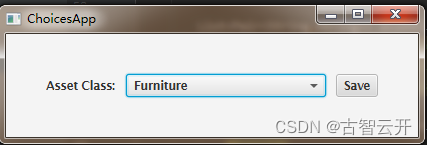1.选择框ChoiceBox
JavaFX的ChoiceBox是一个用户界面控件,用于向用户显示一个选项列表,并允许用户从中选择一个或多个选项。下面是一个ChoiceBox的简单示例和使用介绍:
首先,导入JavaFX的相关类:
import javafx.application.Application;
import javafx.collections.FXCollections;
import javafx.scene.Scene;
import javafx.scene.control.ChoiceBox;
import javafx.scene.layout.VBox;
import javafx.stage.Stage;
在JavaFX应用程序中,创建一个ChoiceBox对象并填充选项:
public class Main extends Application {
@Override
public void start(Stage primaryStage) {
// 创建一个ChoiceBox对象
ChoiceBox<String> choiceBox = new ChoiceBox<>();
// 填充选项列表
choiceBox.getItems().addAll("Option 1", "Option 2", "Option 3");
// 设置默认选择
choiceBox.setValue("Option 1");
// 创建一个布局并将ChoiceBox添加到其中
VBox layout = new VBox();
layout.getChildren().add(choiceBox);
// 创建一个场景并将布局添加到其中
Scene scene = new Scene(layout, 300, 200);
// 设置场景并显示舞台
primaryStage.setScene(scene);
primaryStage.show();
}
public static void main(String[] args) {
launch(args);
}
}
在这个示例中,我们创建一个包含三个选项的ChoiceBox对象,并将其添加到一个垂直布局VBox中。我们设置了默认选项为“Option 1”。最后,我们将布局添加到场景中,并显示舞台。
1.1 字符转换器
当使用复杂对象来支持ChoiceBox时,需要StringConverter。这个对象序列化一个往返于选择框的字符串。对于这个程序,只需要编码toString()来替换Pair对象的默认toString()。(toString和fromString都需要实现才能编译。)
空对象EMPTY_PAIR用于防止nullpointerexception。可以访问和比较assetClass(). getvalue()的返回值,而无需添加特殊的null处理逻辑。
public class ChoicesApp extends Application {
// 创建一个ChoiceBox对象
private final ChoiceBox<Pair<String,String>> assetClass = new ChoiceBox<>();
//创建空Pair对象
private final static Pair<String, String> EMPTY_PAIR = new Pair<>("", "");
@Override
public void start(Stage primaryStage) throws Exception {
Label label = new Label("Asset Class:");
assetClass.setPrefWidth(200);
Button saveButton = new Button("Save");
// 创建一个布局并将ChoiceBox添加到其中
HBox hbox = new HBox(
label,
assetClass,
saveButton);
hbox.setSpacing( 10.0d );
hbox.setAlignment(Pos.CENTER );
hbox.setPadding( new Insets(40) );
Scene scene = new Scene(hbox);
initChoice();
saveButton.setOnAction(
(evt) -> System.out.println("saving " + assetClass.getValue())
);
primaryStage.setTitle("ChoicesApp");
primaryStage.setScene( scene );
primaryStage.show();
}
//创建复杂对象choiceBox
private void initChoice() {
List<Pair<String,String>> assetClasses = new ArrayList<>();
assetClasses.add( new Pair("Equipment", "20000"));
assetClasses.add( new Pair("Furniture", "21000"));
assetClasses.add( new Pair("Investment", "22000"));
assetClass.setConverter( new StringConverter<Pair<String,String>>() {
@Override
public String toString(Pair<String, String> pair) {
return pair.getKey();
}
@Override
public Pair<String, String> fromString(String string) {
return null;
}
});
assetClass.getItems().add( EMPTY_PAIR );
assetClass.getItems().addAll( assetClasses );
assetClass.setValue( EMPTY_PAIR );
}
public static void main(String[] args) {
launch(args);
}
}
2.组合框ComboBox
JavaFX的ComboBox是一个用户界面控件,它结合了文本框和下拉列表,可以向用户显示一组选项,并允许用户从中选择一个或多个选项。下面是一个ComboBox的简单示例和使用说明:
首先,导入JavaFX的相关类:
import javafx.application.Application;
import javafx.collections.FXCollections;
import javafx.scene.Scene;
import javafx.scene.control.ComboBox;
import javafx.scene.layout.VBox;
import javafx.stage.Stage;
在JavaFX应用程序中,创建一个ComboBox对象并填充选项:
public class ComboBoxTest extends Application {
@Override
public void start(Stage primaryStage) {
// 创建一个ComboBox对象
ComboBox<String> comboBox = new ComboBox<>();
// 填充选项列表
comboBox.setItems(FXCollections.observableArrayList("Option 1", "Option 2", "Option 3"));
// 设置默认选择
comboBox.setValue("Option 1");
// 创建一个布局并将ComboBox添加到其中
VBox layout = new VBox();
layout.getChildren().add(comboBox);
// 创建一个场景并将布局添加到其中
Scene scene = new Scene(layout, 300, 200);
// 设置场景并显示舞台
primaryStage.setScene(scene);
primaryStage.show();
}
public static void main(String[] args) {
launch(args);
}
}

在这个示例中,我们创建了一个包含三个选项的ComboBox对象,并将其添加到一个垂直布局VBox中。我们设置了默认选项为“Option 1”。最后,我们将布局添加到场景中,并显示舞台。
除了上述示例,ComboBox还有一些其他特性,例如可以设置最大可见行数、设置下拉列表的最大高度、设置事件监听器等。你可以根据需求来定制ComboBox的使用。
2.1 ComboBox设置选中回调
public class ComboBoxTest2 extends Application {
// 创建一个ComboBox对象
private final ComboBox<Pair<String, String>> account = new ComboBox<>();
private final static Pair<String, String> EMPTY_PAIR = new Pair<>("", "");
@Override
public void start(Stage primaryStage) throws Exception {
Label accountsLabel = new Label("Account:");
account.setPrefWidth(200);
Button saveButton = new Button("Save");
// 创建一个布局并将ComboBox添加到其中
HBox hbox = new HBox(
accountsLabel,
account,
saveButton);
hbox.setSpacing( 10.0d );
hbox.setAlignment(Pos.CENTER );
hbox.setPadding( new Insets(40) );
Scene scene = new Scene(hbox);
//初始化
initCombo();
saveButton.setOnAction( (evt) -> {
if( account.getValue().equals(EMPTY_PAIR ) ) {
System.out.println("no save needed; no item selected");
} else {
System.out.println("saving " + account.getValue());
}
});
primaryStage.setTitle("CombosApp");
primaryStage.setScene( scene );
primaryStage.show();
}
private void initCombo() {
List<Pair<String,String>> accounts = new ArrayList<>();
accounts.add( new Pair<>("Auto Expense", "60000") );
accounts.add( new Pair<>("Interest Expense", "61000") );
accounts.add( new Pair<>("Office Expense", "62000") );
accounts.add( new Pair<>("Salaries Expense", "63000") );
account.getItems().add( EMPTY_PAIR );
account.getItems().addAll( accounts );
account.setValue( EMPTY_PAIR );
//设置选中回调
Callback<ListView<Pair<String,String>>, ListCell<Pair<String,String>>> factory =
(lv) ->
new ListCell<Pair<String,String>>() {
@Override
protected void updateItem(Pair<String, String> item, boolean empty) {
super.updateItem(item, empty);
if( empty ) {
setText("");
} else {
setText( item.getKey() );
}
}
};
account.setCellFactory( factory );
account.setButtonCell( factory.call( null ) );
}
public static void main(String[] args) {
launch(args);
}
}

若此文档不够详细,可以参考JAVAFX基础入门_哔哩哔哩_bilibili
版权归原作者 古智云开 所有, 如有侵权,请联系我们删除。
